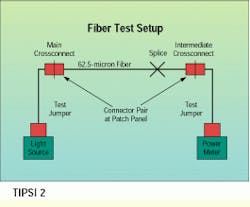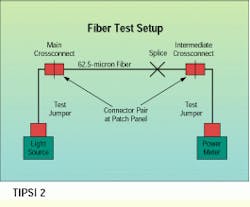Determining optical fiber link loss
Scott F. Andrus, Siecor Corp.
Problem
An optical fiber cable run has been installed between two buildings, with a splice point in the middle linking a third building. It is now time to certify the link with a light source and power meter. The test equipment is set up to test at 850 nanometers. The source is connected to fiber 1 at the main crossconnect and the power meter at the intermediate crossconnect. The loss measured for this fiber span is 4.0 decibels. Is this attenuation acceptable?
Solution
To find the acceptable attenuation for the link, perform a simple link-loss calculation per Annex H of Electronic Industries Association/Telecommunications Industry Association-568A. By using worst-case values for the fiber, connectors and splices, you can calculate the maximum attenuation permitted for the span.
Procedure
1) Determine the optical fiber loss at the testing wavelength--the product of a loss factor times cable length. The optical loss factor is dependent on wavelength--either 850 or 1300 nm for multimode fiber, or 1310 or 1550 nm for singlemode fiber. Fiber loss also varies according to fiber type and performance grade.
Most multimode installations are typically 62.5/125-micron fiber, the performance of which must be 3.75 decibels/kilometer at 850 nm and 1.5 dB/km at 1300 nm to meet or exceed the specification. For singlemode fiber, performance should be at least 0.5 dB/km at 1310 and 1550 nm for outside-plant applications, and 1.0 dB/km for inside-plant applications at both 1310 and 1550 nm .
Cable length can be determined by the foot or meter marks on the cable. Remember to convert feet to kilometers (3281 feet equal 1 km). For example:
Total cable length 0.8 km
Individual fiber loss x 3.75 dB/km
Total fiber loss = 3.0 dB
2) Determine connector loss. When testing from patch panel to patch panel--from main to intermediate crossconnect, for example--there are two connector pairs that need to be accounted for in a link-loss calculation. Do not include the connectors at the light source and the power meter.
The loss for a connector pair typically runs from 0.3 to 1.0 dB, depending on manufacturer. Use the maximum attenuation specified; for example, EIA/TIA-568A specifies a maximum optical attenuation of 0.75 dB for SC- or ST-compatible connectors.
Connector pair loss 0.75 dB
Number of connector pairs x 2
Total connector pair loss = 1.5 dB
3) Determine splice loss. It usually ranges from 0.05 to 0.3 dB. EIA/TIA-568A specifies a maximum loss of 0.3 dB.
Individual splice loss 0.3 dB
Number of splices x 1
Total splice loss = 0.3 dB
4) Determine total attenuation.
The connector pairs at the crossconnects, but not those attached to the power meter and light source, are included in the loss calculation.

